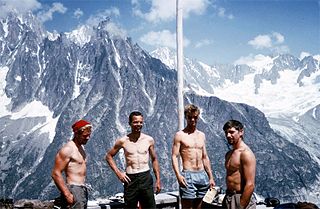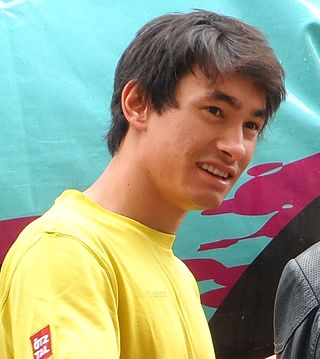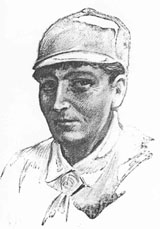Related Research Articles

Reinhold Andreas Messner is an Italian climber, explorer, and author from the German-speaking province of South Tyrol. He made the first solo ascent of Mount Everest and, along with Peter Habeler, the first ascent of Everest without supplemental oxygen. He was the first person to climb all 14 eight-thousanders, doing so without supplementary oxygen. Messner was the first to cross Antarctica and Greenland with neither snowmobiles nor dog sleds and also crossed the Gobi Desert alone. He is widely considered to be the greatest mountaineer of all time.

In mountaineering and climbing, a first ascent, is the first successful documented climb to the top of a mountain or the top of a particular climbing route. Early 20th-century mountaineers and climbers focused on reaching the tops of iconic mountains and climbing routes by whatever means possible, often using considerable amounts of aid climbing, and/or with large expedition style support teams that laid "siege" to the climb.

The Eiger is a 3,967-metre (13,015 ft) mountain of the Bernese Alps, overlooking Grindelwald and Lauterbrunnen in the Bernese Oberland of Switzerland, just north of the main watershed and border with Valais. It is the easternmost peak of a ridge crest that extends across the Mönch to the Jungfrau at 4,158 m (13,642 ft), constituting one of the most emblematic sights of the Swiss Alps. While the northern side of the mountain rises more than 3,000 m (10,000 ft) above the two valleys of Grindelwald and Lauterbrunnen, the southern side faces the large glaciers of the Jungfrau-Aletsch area, the most glaciated region in the Alps. The most notable feature of the Eiger is its nearly 1,800-metre-high (5,900 ft) north face of rock and ice, named Eiger-Nordwand, Eigerwand or just Nordwand, which is the biggest north face in the Alps. This substantial face towers over the resort of Kleine Scheidegg at its base, on the eponymous pass connecting the two valleys.

Duncan "Dougal" Curdy MacSporran Haston was a Scottish mountaineer noted for his exploits in the British Isles, Alps, and the Himalayas. From 1967 he was the director of the International School of Mountaineering at Leysin, Switzerland, a role he held until his death in an avalanche while skiing above Leysin.

Lionel Terray was a French climber who made many first ascents, including on the 1955 French Makalu expedition in the Himalaya and Cerro Fitz Roy in the Patagonian Andes.

Peter Habeler is an Austrian mountaineer. He was born in Mayrhofen, Austria. He developed an interest in mountain climbing at age six.

John Elvis Harlin II was an American alpinist and US Air Force pilot who was killed while making an ascent of the north face of the Eiger at age 30.
Andreas "Anderl" Heckmair was a German mountain climber and guide who led the first successful ascent of the Eiger north face in July 1938.

The Tre Cime di Lavaredo, also called the Drei Zinnen ; pronounced[ˌdʁaɪˈtsɪnən] ), are three distinctive battlement-like peaks, in the Sexten Dolomites of northeastern Italy. They are one of the best-known mountain groups in the Alps. The three peaks, from east to west, are:
Michael Dacher was a German mountain climber. In 1979 he and Reinhold Messner climbed the K2 in record time and without oxygen equipment.

Catherine Destivelle is a French rock climber and mountaineer who is considered one of the greatest and most important female climbers in the history of the sport. She came to prominence in the mid-1980s for sport climbing by winning the first major female climbing competitions, and by being the first female to redpoint a 7c+/8a sport climbing route with Fleur de Rocaille in 1985, and an 8a+ (5.13c) route with Choucas in 1988. During this period, she was considered the strongest female sport climber in the world along with Lynn Hill, however, in 1990 she retired to focus on alpine climbing.
Reinhard Karl was a German mountaineer, photographer and writer.

David Lama was an Austrian rock climber and alpinist. He won the European Championship in competition bouldering in 2007 and the European Championship in competition lead climbing in 2006. He is known for his first free ascent of the Compressor Route on Cerro Torre. In 2018, in a solo expedition, he was the first to reach the summit of Lunag Ri in the Himalayas. In 2019, he was posthumously honoured with a Piolet d'Or for this first ascent.

Jeannette Friederike Hermine Immink was a Dutch mountaineer. She climbed extensively in the Dolomites with several first ascents and is credited as a pioneer in the field of women's climbing.

Yvette Vaucher was a Swiss mountaineer and parachutist. Credited as Switzerland's first female parachutist, she was also the first woman to climb the Matterhorn's north face.

Alpine climbing is a type of mountaineering that involves using any of a broad range of advanced climbing skills, including rock climbing, ice climbing, and/or mixed climbing, to summit typically large routes in an alpine environment. While alpine climbing began in the European Alps, it is used to refer to climbing in any remote mountainous area, including in the Himalayas and in Patagonia. The derived term alpine style refers to the fashion of alpine climbing to be in small lightly-equipped teams who carry their own equipment, and do all of the climbing.

Ines Papert is a German alpine climber, and a world champion ice and mixed climber best known for her competition ice climbing awards and difficult alpine ascents. She has made a number of first ascents and has broken difficulty grade milestones for female climbers.
The recorded history of climbing of the Eiger mountain in Switzerland starts in the 1800s. It is split between the pre-north face era, when the main summits and easier ridges and faces were climbed, and the post-north face era, when it became one of the greatest prizes in mountaineering. At least sixty-four climbers have died while attempting the ascent.
References
- 1 2 3 4 5 6 7 8 9 "Daisy Voog" (PDF) (in German). Historisches Alpenarchiv. January 3, 1985. Retrieved April 21, 2014.
- 1 2 3 4 Mauz, Gerhard (June 30, 1965). "DER DREIGETEILTE WEG NACH OBEN". Der Spiegel (in German). Retrieved April 21, 2014.
- ↑ "Von ZEIT zu ZEIT". Die Zeit (in German). July 2, 1965. Retrieved April 21, 2014.
- ↑ Grabne, Martin (July 30, 2010). "Der Berg ist eine Frau". Der Standard (in German). Retrieved April 21, 2014.